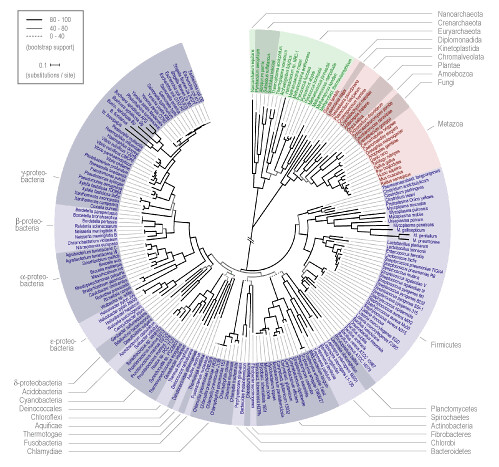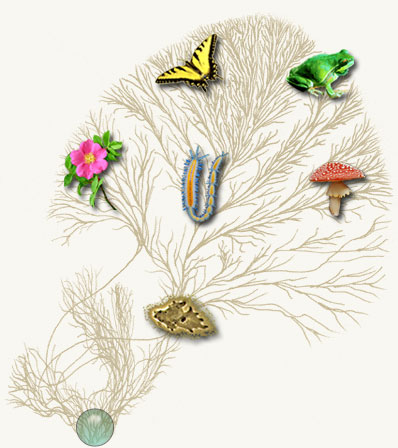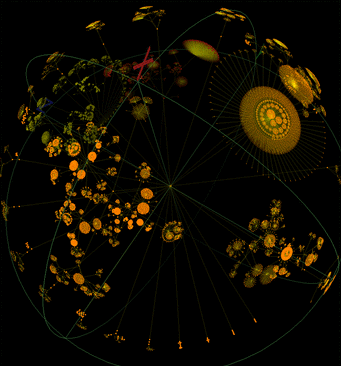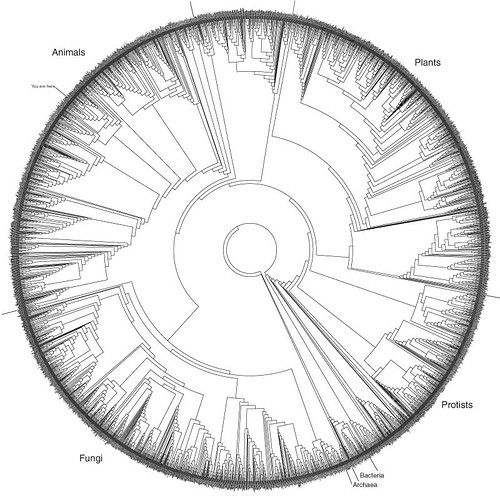Phylogeny - Tree of Life

Since I used some big words and concepts without explanation in my last post about the Sarcophaga sp. fly, I thought I would do a little discussion with links here about Phylogeny and the Tree of Life.
Humans have always been driven by curiosity to learn about the world around them. After making some observations about a particular living thing, a name is needed for that thing to be able to communicate your findings to other people. For this reason, the naming, description, and characterization of all the species known to us started early on. With time, relationships between various animals and plants became part of how that thing is described. So first generation "maps" of being-to-being relationships began to be made and shared in the growing neo-scientific communities.
Second generation maps began to form with a growing understanding of the developmental changes in animals over time to form new species or distinct types of animals or plants that can not breed outside of their species group.
Thus, today, we have many maps of our natural world. A good link to one of these can be found at:
The Tree of Life Web Project

As there are something like 1.8 million described organisms, drawing a truly representative map of our biological world can be difficult. A site that serves as an index of some of the more successful maps is found at this link.
Here is an example of a dynamic space filling model of an evolutionary map. This was generated by the WALRUS modeling program using data from all organisms cataloged on the NCBI taxonomy database, which currently contains approx. 180,000 nodes

A neat map that shows the complexity of the tree of life. A PDF version printing is here.

In aide of your quest to teach about the natural world and evolution to your kids (and yourself!) try this amazing resource at Berkeley University called The Berkeley Evolution Project for Teachers.
Phylogeny Glossary:
Evolution: Genetic changes in lineages of organisms over time. Through this process, a lineage may split and diversify into new species.
Links to further understanding of Evolution are here and here.
Phylum: is a taxon used in the classification of life, adopted from the Greek phylai the clan-based voting groups in Greek city-states. WIKI link
Phylogeny: The evolutionary history of a group of organisms.
Any group of species are descended from a common ancestral species, which, over time, split into two species, with these descendents splitting again, and again, until the entire collection of species was produced through evolution and speciation (the splitting of a lineage). The genealogical connections thereby formed in general take the shape of a tree, called the phylogeny of the group.
Link for further understanding of phylogeniesPhylogenetics: The scientific discipline of resolving phylogenetic relationships between organisms.
Species: A leaf on the tree of life. A group of organisms that share a common gene pool as well as a unique evolutionary history distinct from other groups of organisms.
Speciation: The splitting of an evolutionary lineage producing (usually) two new, separate species, which thus begin their own, unique evolutionary histories.
Link for further understanding of SpeciationTaxon: taxon (plural taxa), or taxonomic unit, is a grouping of organisms (named or unnamed). Once named, a taxon will usually have a rank and can be placed at a particular level in a hierarchy. WIKI link
This LINK is an excellent resource for teach evolution, even with lesson plans!
4 Comments:
-
Awesome post! I have to revisit with my hubby - the evolution freak. We can't wait to get into evolution with our boys!
By Melissa, at 11:38 AM -
glad you liked it :-) So nice to know that SOMEONE will get into the post besides us :-)
By nika, at 11:47 AM -
Wow! Any idea where I can get a poster of that cool round evolutionary map? This is way cool. BTW, you wouldn't have any useful info about teaching taxonomy would ya? Thanks so much for posting this.
By Rebecca Trotter, at 10:05 PM -
Rebecca: The B&W one has a link for a PDF that you could print.. The color one was printed in Science Mag. I can not find anywhere that they have put it out in a poster format. I am still looking for resources on that, check back!
By nika, at 9:37 AM
Here is an excellent link for online student learning on evolution (http://www.pbs.org/wgbh/evolution/educators/lessons/index.html)
Here is the companion for educator learning on evolution (http://www.pbs.org/wgbh/evolution/educators/course/index.html) (I am going to do this for sure)
Here is the Berkely link for learning this topic (http://evolution.berkeley.edu/)
Found a great link at Science for educator materials we can order (http://www.aaas.org/publications/store/theme/educators.shtml)
Local resources for science ed. (http://www.tryscience.org/parents/se_2.html)
Some links for teaching taxonomy:
http://www.101science.com/Taxonomy.htm
http://www.pbs.org/safarchive/5_cool/galapagos/g52b_tax.html
http://www.pbs.org/safarchive/5_cool/galapagos/g42_tax.html
a meta listing of teaching taxonomy resources - http://www.lessonplanet.com/search/Science/Biology/Taxonomy?startval=10
Post a Comment
<< Home
nika :: permalink


